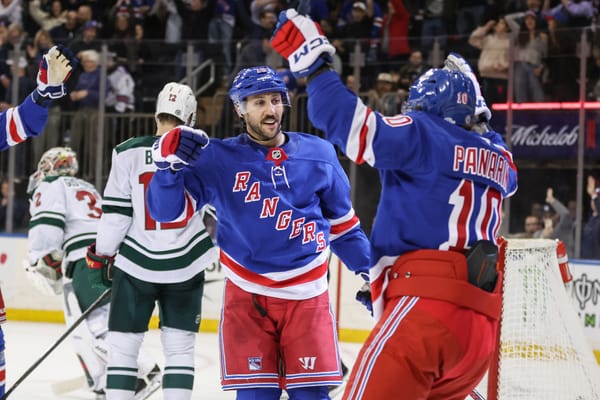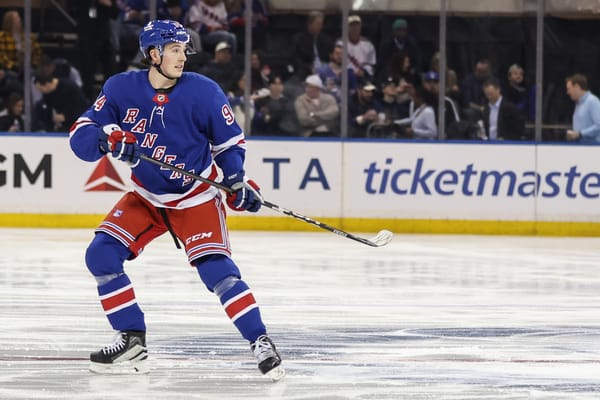Neal Pionk is Complicating the Rangers’ Defensive Logjam
The 23-year-old defenseman is developing into a jack of all trades
The New York Rangers’ decision to rebuild their roster was one made based on the summation of holes that were created over years of attempts at an elusive Stanley Cup Championship. Though no particular area of the organization was solely to blame for the this reset, or maybe even their failure to capture one over that span, no position left both fans and management wanting more than on defense.
The Blueshirts’ blue line never quite met the bar required to put them over the top and was made significantly worse in the immediate wake of the Ryan McDonagh and Nick Holden trades that left a weakened group on life support to close out last season.
Thanks to a collection of draft picks and players acquired in trades since last February, help is on the way. Yegor Rykov, K’Andre Miller, Ryan Lindgren, Nils Lundkvist, and Libor Hajek are all likely to be leaned on for NHL roles, even if they’re all various years away from viability.
That wait can feel like an eternity, though. Especially if you’re living and dying by every game played between now and then — games in which more losses than wins are likely to be experienced. Thankfully, as the Rangers continue to ice a placeholder D-group through the onset of this season, a bright spot appears to be emerging this season in the shape of Neal Pionk.
Originally signed as a highly-coveted undrafted free agent in May of 2016, the now-23-year-old entered New York’s training camp this past summer hopeful to crack a blue line in need of overhaul, but inconveniently anchored with numerous multi-year veteran contracts.
As camp and preseason drew to a close, it became painfully apparent that Pionk was likely competing in something of a head-to-head with Tony DeAngelo – himself in a similar position of needing the requisite runway to carve out a full-time role on Broadway. It was a competition only complicated by the August addition of Adam McQuaid that added yet another right side rearguard to the mix.
Pionk did make the team (along with seven other defensemen) and despite a handful of healthy scratches as David Quinn — who is still getting a handle on who his long-term pieces might be — continues to shuffle players around like lottery balls in a tumbler, appears to look more confident with each game played.
Recency bias and the sample size notwithstanding, his return affair against the Washington Capitals last Wednesday night was as encouraging as it gets given he fresh off the heels of a two-game healthy scratch streak.
Despite the Rangers dropping the game 4-3 in overtime, Pionk appeared poised and confident with the puck through to the final buzzer. He finished the night with three assists, including a primary helper on Chris Kreider’s third period game-tying goal that helped send the contest into sudden death in the first place.
His performance was assertive and strong. His skating, particularly with the puck, was commanding. And his first pass put the defending Stanley Cup champions on their heels throughout the evening.
But most of all, his execution stood in testament to Quinn’s comments regarding Pionk’s status with the club following the head coach’s decision to bench him for the game against the Oilers on October 13th.
“Pionk is going to play a lot of hockey for us,” Quinn said of his decision to sit the second-year pro. “He and I have talked. I don’t want to reveal our lineup for our next game, but he’s a guy I like an awful lot, and he’s going to play a lot for us.”
That message was received, loud and clear, despite the fact that Pionk wouldn’t climb back into the lineup until last Wednesday night, instead again made a healthy scratch against the Colorado Avalanche on October 16th.
But all the while, Pionk (not to mention DeAngelo), is fighting for ice time and a meaningful role on a logjam defense made worse by the decision to carry eight defenders to start the season. It’s bad enough with seven. Eight is simply untenable for any sizable stretch of time.
Should Pionk’s pace maintain, even at a reduced rate, his play could force the Rangers to alter that eight-man layout earlier than they anticipated, either via trade or demotion. As they currently sit, however, only Pionk is still waivers-exempt. That means if the solution the Rangers seek is to simply stash an extra defender in Hartford, the only way to accomplish that without exposing one of theirs to waivers is to send Pionk — the optics of which could look rather ugly if he remains even half as productive by that point.
Were Pionk to be made the casualty, the Rangers would need to battle the inevitable PR problem of demoting a 23-year-old while Marc Staal (31) and Adam McQuaid (32) remain in the show, but the club would have an argument to be made based on shot metrics.
Again, sample size notwithstanding, Pionk has been among the team’s worst performers in numerous categories this season including game score (minus-0.6), Corsi for percentage (39.29), and relative Corsi-for (minus-12.19) — all of which he ranks dead last in. This can’t simply be chalked up to a bad start, either, given his career numbers are no better. With just over 600 minutes played over 33 games spanning the last two seasons, Pionk again ranks dead last among Rangers defenseman at even strength in both CF% (41.5) and relative CF% (minus-7.34), although his role last season has to be considered for context.
Remember, though: through all of this, this is still year one of a rebuild designed to improve the roster and reduce the average age of the roster, not increase it. Fact is, the Rangers’ blue line is already quite old even with Pionk on the roster. It would only get older without him. While none of the aforementioned youngsters, sans perhaps Libor Hajek, is likely ready for a full-time NHL role yet, again, it’s the optics we’re speaking to here, not necessarily the logic.
Perhaps this is a case where the eye test (which Pionk often passes with flying colors) is sunk by the data. Perhaps that’s all the Rangers need (or want) to feel comfortable making a move to better stabilize their back-end. Or, perhaps even none of this would matter had the Rangers simply opted not to acquire Adam McQuaid so late in the summer. I’m not entirely sure that would prove true given Fredrik Claesson’s ability and willingness to play both sides of the ice, but regardless, eight defensemen isn’t a lasting philosophy, and was never designed to be.
Sooner or later something has to give. Not for monetary reasons, but pragmatic ones. It’s simply not possible to run the marathon of an entire season with this many options for a position that relies so heavily on playing time to gauge effectiveness. And this says nothing of the fact that this season is going to be highly evaluative, thus begging the question of just how well any young player can be graded in such a manner if they aren’t given room to breathe.
Pionk still leaves much to be desired away from the puck — that much is borne out by the analytics, for sure — but his play with it is arguably the strongest reason to see if an extended stretch of play can’t shift the tide in his favor.
Whether or not the Rangers play the easy card and stash their only waivers-exempt defender in Hartford for the time being, or seek a trade, or even both, only time will tell. But Pionk isn’t making that choice any easier. Not so long as he continues to have night’s like the one he did last Wednesday in Washington D.C.
Data via Corsica.hockey, taken prior to Sunday night’s matchup against the Calgary Flames




